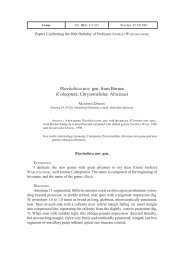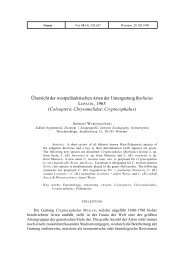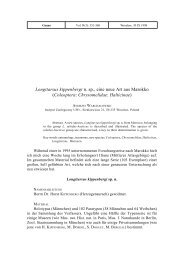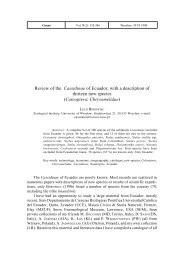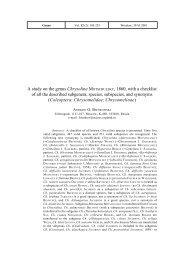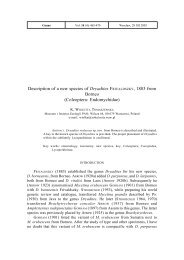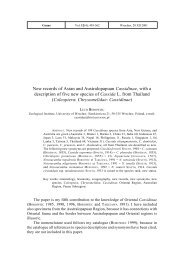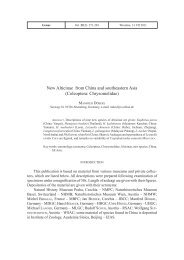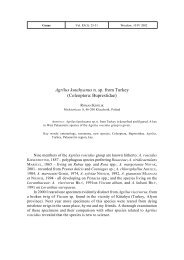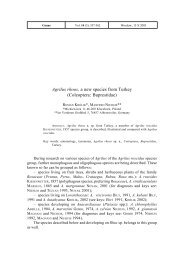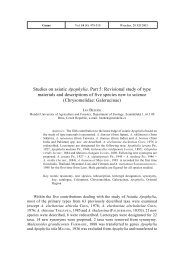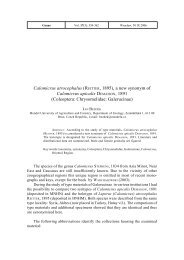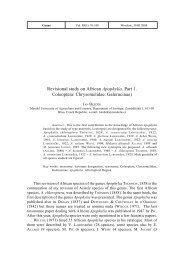A preliminary study and review of the genus Stylosomus SUFFRIAN ...
A preliminary study and review of the genus Stylosomus SUFFRIAN ...
A preliminary study and review of the genus Stylosomus SUFFRIAN ...
Create successful ePaper yourself
Turn your PDF publications into a flip-book with our unique Google optimized e-Paper software.
420 AndrZEj WArCHAłoWSKI<br />
17. Species from Medirerranean area. Elytra under 2.5 × longer than pronotum<br />
........................................................................................................................... 18.<br />
−. Species from Transcaspia. Elytra over 2.6 × longer than pronotum. relatively large<br />
species, body length over 3.0 mm .................................................................... 19.<br />
18. In typical form pronotum with very weak darkenings only, almost entirely pale, on<br />
elytra black colour forms x-like pattern. general appearance as in plate 2, fig. 18. Aedeagus<br />
in dorsal view almost parallel, on apex slightly narrowed <strong>and</strong> transversely cut,<br />
flagellum shortly protruding; in lateral view gently bent, towards apex not thickened,<br />
but ra<strong>the</strong>r somewhat flattened. distributed in nW Algeria, Morocco <strong>and</strong> S Spain<br />
................................................................................................. xsignum Pic, 1899.<br />
−. In typical form black colour does not form an x-like pattern. general appearance<br />
as in plate 2, fig. 17. Apex <strong>of</strong> aedeagus (figs 23, 24) not rounded, but less or more<br />
shortly, obtusely triangular, anterior part <strong>of</strong> lamina dorsalis relatively narrow, about<br />
2 × narrower than <strong>the</strong> breadth <strong>of</strong> tubular part. Tubular part in lateral view thickened<br />
towards apex. Exterior interstices <strong>of</strong> elytra ra<strong>the</strong>r flattened, covered with hairs longer<br />
than double diameter <strong>of</strong> punctures. In typical form upper side pale testaceous with<br />
two brownish spots on anterior part <strong>of</strong> pronotum <strong>and</strong> with blackish sutural stripe<br />
dilated in scutellar area. Tarsi <strong>and</strong> sternum blackish, abdomen in female testaceous,<br />
in male dark brown or blackish. Length 1.6-2.3 mm. forms numerous colour variations<br />
(see <strong>review</strong> <strong>of</strong> species) distributed widely in western part <strong>of</strong> Mediterranean<br />
area from Morocco to dalmatia. <strong>and</strong> ?fur<strong>the</strong>r easterly to Central Asia (see remark to<br />
S. flavus, couplet 11) ........................................ tamarisci (HerricH-ScHäffer, 1838).<br />
19. Length <strong>of</strong> body over 3.0 mm (male about 3.0 mm, female about 3.4 mm). Pronotum<br />
<strong>and</strong> elytra dark brown or pitchy, margined with yellowish.Aedeagus not studied.<br />
described from Kirgizstan ....................................................... cheni LopAtin, 1962.<br />
−. Body on average shorter. Upper side pale, testaceous or pale rusty-brown, on pronotum<br />
<strong>of</strong>ten two blackish spots. Pronotum relatively short <strong>and</strong> broad. Puncturation<br />
<strong>of</strong> upper side very strong. general appearance as in phot. 12. Aedeagus not studied.<br />
Length 2.6-3.0 mm. distributed in SE Kazakhstan, E Uzbekistan <strong>and</strong> Kirgizstan<br />
.............................................................................................. fausti reitter, 1894.<br />
19-24 (orig.). Aedeagus in dorsal <strong>and</strong> lateral view: 19, 20 − S. (<strong>Stylosomus</strong>) nigrifrons, 21, 22 - S. (S.) subelongatus,<br />
23, 24 − S. (S.) tamarisci



